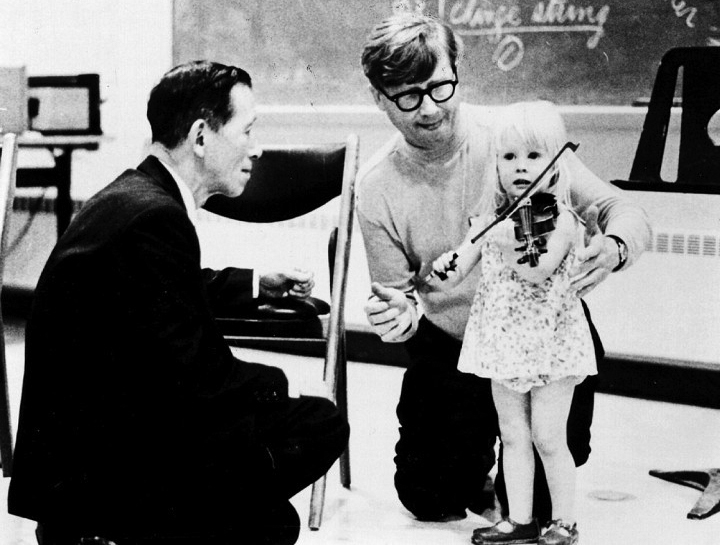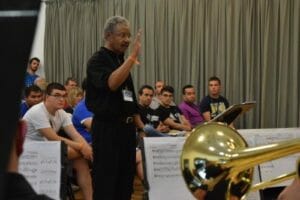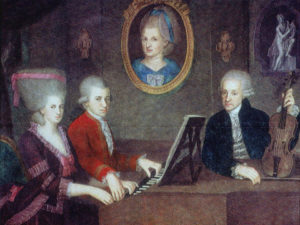
Most parents understand that it is a good thing for even very little children to study music, and for all sorts of reasons besides one day becoming a professional musician.
Dalcroze Eurhythmics was developed early in the 20th century by Swiss musician and educator Émile Jaques-Dalcroze (1865-1950), teaching concepts of rhythm, structure, and musical expression, using movement. It focuses on allowing the student to gain physical awareness and the experience of music through training that takes place through all of the senses, particularly the kinesthetic.
The Suzuki Method dates from the middle of the 20th century, founded by Japanese violinist and teacher Shinichi Suzuki (1898-1998). The method aims to create an environment for learning music which parallels the linguistic environment of acquiring a native language, an environment which Suzuki believed would also help to foster good moral character.
El Sistema, developed first in Venezuela by José Antonio Abreu (1939-2018), aims to use orchestral training as a means for keeping young people off the streets in a dangerous environment, focusing their attention on academic studies and music making.
When it comes to studying music in middle and high school, we focus on skills in brass and woodwind playing as part of the necessary accompaniment that goes with a football game. The study of woodwind instruments often leads to the ambition of earning a paying position in one of our major orchestras, though the proportions of people who study woodwind, brass, and string instruments versus the number of actual positions available in an orchestra greatly favor the string players.
In order to prepare students for work in an orchestra, we teach them how to play in large ensembles without asking questions that take rehearsal time. In a country whose companies are organized hierarchically, this skill has practical applications outside of music, but is it a skill we ought to be prioritizing? In small ensembles, musical success depends on the ability of those participating to create musical meaning as the result of human debate and compromise.
As U.S. orchestras struggle financially and competition among players continues to increase, the responsible thing to do as music educators is to shift our priorities to areas such as keyboard playing, critical thinking, and entrepreneurial skills. Towards that aim, we might focus music history courses less on composers and more on the history of musical institutions. These topics would help prepare music students for the more economically feasible, yet still artistically viable, world of performance in smaller ensembles.
In other words, our curricula need to start fostering the development of better-rounded musicians. Since the time of our Civil War we have been content with isolating different kinds of music making largely into the hands of different sets of musicians, isolating such to performances in different kinds of performance venues. We should remember that J.S. Bach was not simply a composer but the best organist of his day, the organizer of music making in his community, a string player, a conductor, an examiner of organs, a school teacher, and the father of 20 children.
Only in the past quarter century have we begun to let different kinds of music and music-making influence each other again. Try sometime on YouTube to decide whether the following three works of William Bolcom are “serious” or “popular:” his chorale prelude for organ “What a Friend We Have in Jesus,” his virtuoso piano rag The Serpent’s Kiss, or any of his Cabaret Songs. In all these works the composer succeeds brilliantly in doing away with the stylistic considerations that used to separate different styles of music into completely different worlds.
Who should study music, then? In today’s landscape, the most successful professional musicians tend to be ones who, like Bolcom, are flexible, entrepreneurial, and curious. They are able to lead the church choir on Sunday, play the lounge gig on Saturday night, and present their percussion ensemble in small concert halls from time to time, all while maintaining a studio dedicated to teaching nonprofessional enthusiasts.
Speaking of those enthusiasts, they are key to nurturing a musical economy that sees essential revenue flowing in from outside sources since they are likely not only to attend more performances themselves but also to bring friends and family into the concertgoing fold, exponentially expanding the market. Really, it is anyone who finds (s)he has a positive reaction to music and the experience of playing it who should study it as a hobby.
Why, then, should the enthusiast set time aside time for continued musical study? The already-mentioned extramusical benefits of honing the senses, developing a good moral sense, and keeping busy at a creative and positive activity are all compelling reasons; but music’s intrinsic power to challenge the mind and lift the soul are reason enough on their own. As music educators, we are tasked with being champions of both sorts of benefits to musical study, not just for the next aspiring orchestral clarinetist but also for hobbyists at all levels.
What do you think? What benefits has musical study brought you (or people you know) in the non-musical world? I invite you to engage in the comments section below.
Inspire Learners of All Levels
Visit our Educators page to learn how MITA helps hobbyists and aspiring professionals alike to engage more meaningfully with music.



